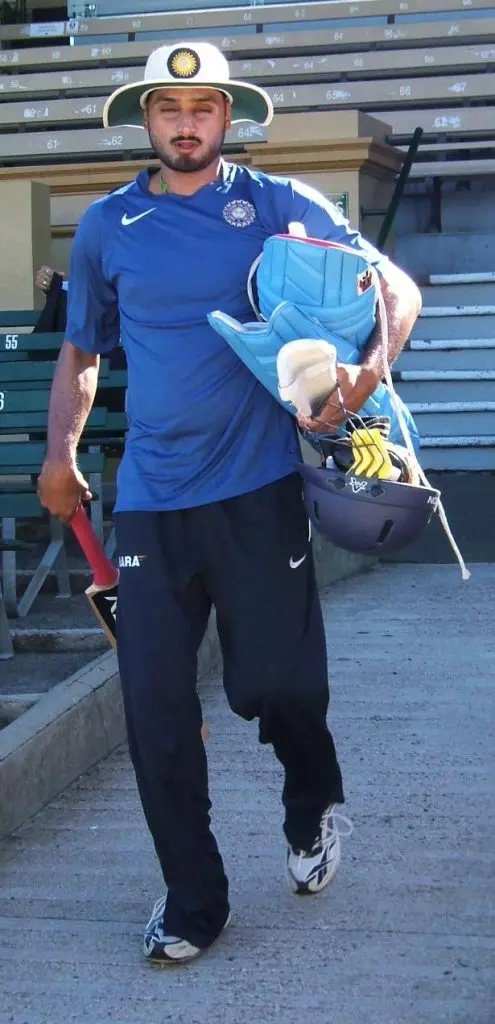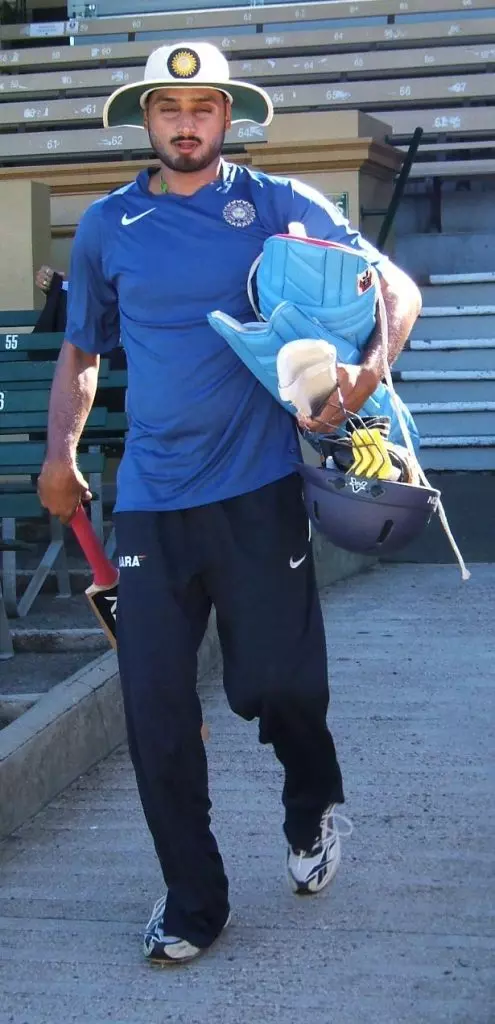
Harbhajan Singh, also known as ‘Bhajji’ and ‘The Turbanator,’ is an Indian cricketer who, after Sri Lanka’s Muttiah Muralitharan, is the second-highest wicket-taker in Tests. Singh represents Punjab in domestic cricket and spent a decade with Mumbai Indians in the IPL before joining Chennai Super Kings. Though his early career was plagued by inquiries into his bowling action, the specialist spin bowler did not disappoint Sourav Ganguly, the then-captain, who had asked him to stand in for the injured Anil Kumble in the 2001 Border-Gavaskar Trophy against Australia.His later career was marked by ups and downs, with him being entangled in a number of scandals, most notably the ‘Monkey-gate’ incident involving Australia’s Andrew Symonds and the ‘Slap-gate’ incident involving Indian teammate Sreesanth. Though Singh was frequently overshadowed by legendary spinner Anil Kumble before the latter’s retirement, he regularly outperformed him. He holds a variety of unusual records, including dismissing former Australian captain Ricky Ponting ten times in Tests.
Childhood and Puberty
Harbhajan Singh Plaha was born in Jalandhar, Punjab, India, on July 3, 1980. His boss, Sardar Sardev Singh Plaha, ran a ball bearing and valve factory, and his mother, Avtar Kaur, worked as a housewife. Harbhajan is the youngest of five sisters.
Harbhajan wanted to be a batsman and was studying the basics of batting from coach Charanjit Singh Bhullar before training as a spin bowler under coach Davinder Arora. Harbhajan began to gravitate toward off-spin bowling after Bhullar’s passing. Instead of entering the family business, his father urged him to seek a career in cricket.
Career In Domestic
Harbhajan Singh made his domestic debut for the Punjab Under-16s team against Haryana in November 1995 when he was 15 years old. He was picked for the North Zone Under-16s team with 32 wickets and 96 runs, and he was also invited to join the national Under-19 team for a youth ODI against South Africa.
During the 1997–98 Ranji Trophy season, he was promoted to the Punjab Under-19s and made his first-class debut against Services. He was chosen to represent North Zone in the Duleep Trophy, but his team was defeated by East Zone by 5 wickets. In January 1998, he represented India in the Under-19 World Cup.
Career In International
Before the 1997-98 Test series, Harbhajan Singh was called up to play for the Indian Board President’s XI against the visiting Australian team. He was left out of the first two Test matches due to his bad results in the trial match. On March 25, 1998, he made his international debut in the third Test, taking just one wicket. He made his ODI debut against New Zealand in Sharjah in April, despite being overlooked for the home series between India, Australia, and Zimbabwe.
After a series of bad results following his debut in 1998, Singh was benched for a while before returning to play in the Singer Trophy. In six games, he took eight wickets, including one in the final. He was left out of the Sahara Cup squad after that, but he did represent India at the 1998 Commonwealth Games.
He made his last ODI appearance for India in more than two years during the 1998-99 season against Zimbabwe, after which he returned to domestic cricket. He took 4/91 for the Board President’s XI during the 1999 home series against New Zealand and was retained for the subsequent Test series. In two matches, he managed to take six wickets.
In 2001, captain Sourav Ganguly shocked Singh by telling him to lead the spin attack against Australia in the Border-Gavaskar Trophy because Anil Kumble was injured. Singh had a brilliant series, taking 32 wickets to help India win 2-1. He was also the first Indian to take a Test hat-trick, in addition to being appointed ‘Man of the Series.’
Singh struggled in one-day internationals against Australia and Zimbabwe in 2001, but he took 11 wickets in seven matches on Sri Lanka’s spin-friendly surface. He went on to take 7/110 in a Test match against England at his home ground of Mohali, including 5/51 in the first innings. In the next match, he picked up another five wickets.
He did well during India’s 2001 tour of Zimbabwe, but was injured in mid-2002 while playing in the West Indies, where he failed to take wickets except in the final match, in which he took eight. Later in his career, he played in Test matches against England, the NatWest Series, and the 2002 ICC Champions Trophy in Sri Lanka, where he had a mixed results.
In the Test series against the West Indies in India, his score improved. With 20 wickets and 69 runs, he was named the ‘Man of the Series.’ In the 2003 World Cup, he had a consistent result, taking 11 wickets at a 3.92 economy average.
Singh hurt his finger during the 2003 World Cup, so instead of undergoing operations, he opted to use physiotherapy to treat his discomfort. However, as his health worsened, he was forced to undergo major surgery, which forced him to sit out for seven months.
Harbhajan regained his form after a time of rest by representing India in the Asia Cup in July 2004 and the 2004 ICC Champions Trophy. During the home series against Australia, he returned to Test cricket and played admirably with both the ball and the bat, but he was unable to save his team from a 2-1 defeat.
His form started to deteriorate again by the end of the season, so he spent the off-season playing for English county club Surrey in an effort to strengthen his game. He was under fire after openly denouncing new coach Greg Chappell and defending captain Ganguly in one of Indian cricket’s most notorious scandals. Following that, he put in good performances against Sri Lanka in both Test and ODI matches in 2005.
SIngh’s form began to deteriorate in 2006, and he was dropped after a disappointing showing at the 2007 World Cup. He did, however, lead to India’s success in the ICC World Twenty20 tournament. Throughout the season, he put in several match-winning performances to become India’s top wicket-taker and the world’s third-highest wicket-taker.
Singh talked with Australian all-rounder Andrew Symonds during a test match in Australia during the 2007-08 Border-Gavaskar Trophy. Singh reportedly called Symonds an ape, a racially motivated slur, according to Symonds. Singh was barred from participating in the next three matches, and the Indian team threatened to withdraw from the series. India went on to win the series 2-1, and Singh’s suspension was lifted.
In the 2009 Twenty20 World Cup, he had a mixed result, and India was eliminated early. In the 2009 ICC Champions Trophy, he struggled, but returned in the 2010 season. He was a part of the Indian team that won the World Cup in 2011, but due to an injury, he was not included in the following season.
He then turned his attention to the IPL, captaining Mumbai Indians to the 2011 Champions League Twenty20 championship. In 2014-2015, his success in the IPL won him a return to international cricket, which he used to exceed Wasim Akram’s total and become the ninth highest wicket-taker in Tests.
He was called to the Indian Test squad against Sri Lanka in 2015. Later in the ODI series against South Africa, he was called in to substitute injured allrounder Ravichandran Ashwin. Following that, Singh played three T20 matches against Australia, a home T20 series against Sri Lanka, and the 2016 Asia Cup (T20) in Bangladesh. He was also picked for the 2016 T20 World Cup, which will be hosted in India. Although he was named to the Indian team for a number of episodes, he was scarcely used in the playing 11.
He was left out of the Indian squad for the 2017 Champions Cup, which was held in England. Singh is said to have said after learning of his omission that he was “not having the same rights that other seasoned cricketers, including MS Dhoni, have been afforded by the national selectors.” In the Indian cricket community, his comment ignited a lot of discussion.
Achievements & Awards
Harbhajan Singh is the second-highest wicket-taker in Tests as an off-spinner and the 11th-highest wicket-taker overall. In Test cricket, he was the first Indian bowler to take a hat-trick.
He was awarded the Padma Shri, India’s fourth highest civilian distinction, in 2009.
